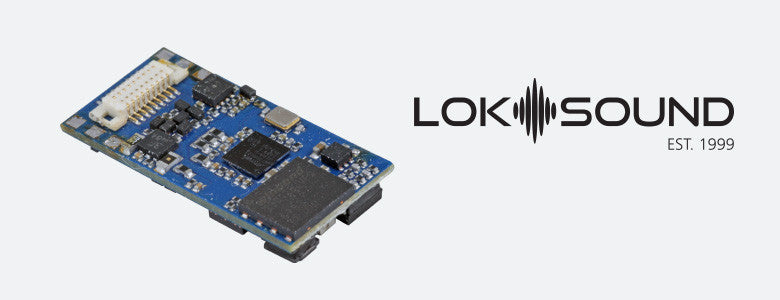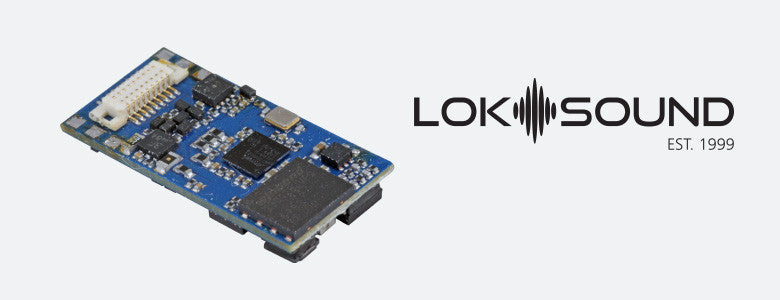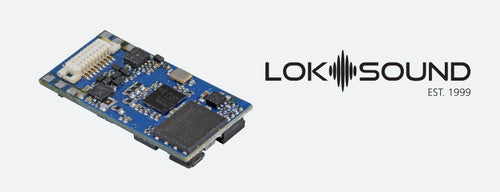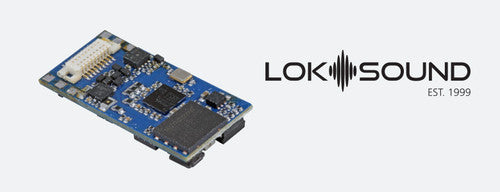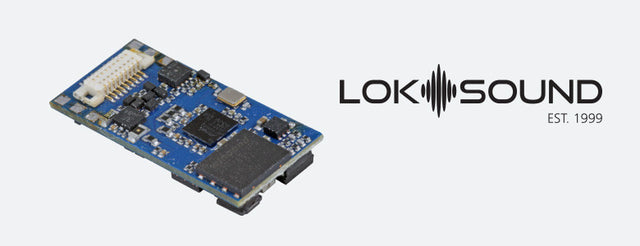58810 ESU LokSound / Ver 5 Micro DCC-MM-SX-M4 Multi-Prototcol Sound and Control Decoder 8 pin ribbon cable (SCALE= ALL) Part # 397-58810
58810 ESU LokSound / Ver 5 Micro DCC-MM-SX-M4 Multi-Prototcol Sound and Control Decoder 8 pin ribbon cable (SCALE= ALL) Part # 397-58810 is backordered and will ship as soon as it is back in stock.
Couldn't load pickup availability
Description
Description
58810 ESU LokSound / Ver 5 Micro DCC-MM-SX-M4 Multi-Prototcol Sound and Control Decoder 8 pin ribbon cable (SCALE= ALL) Part # 397-58810
If you need the sound file programmed to the decoder Yankeedabbler will load the sound file for you at no additional cost, if you add the sound file number or locomotive type (ie GP38) in the "add order note" of your order. The "Add order Note" is located in the lower left corner of your cart. If nothing is in the add order note the decoder will be sent out directly to you and you will need to program the decoder.
You can see the ESU Sound Library by clicking the link (North American and AUS Files: https://projects.esu.eu/projectoverviews/18). The link is for the North American and AUS sound files but we can load any ESU sound file to the decoder just tell us the ESU sound file number or the type of locomotive.
Or you can purchase a LokProgrammer from us (stock number 53452). However, it is not necessarily required as decoders can be purchased with sound files preloaded and CV Changes can be done using control systems.
The LokSound 5 Micro DCC-MM-SX-M4 Multi-Prototcol Sound and Control Decoder by ESU is by far the smallest LokSound decoder. Measuring only 13/16 x 13/32" 21 x 10mm it should fit into all N gauge and TT locomotives and is also suitable for small HO locos too. All LokSound decoders are equipped with a Next18 interface and are available with adapter plugs to suit all popular digital interface types. The decoder is supplied with a 7/16 x 19/32" 11 x 15mm sugar cube speaker and sound enclosure set.
The LokSound 5 micro is a true multi protocol decoder. It supports DCC as well as Motorola, Selectrix and M4. Of course it supports 14 through to 128 speed steps as well as 2 and 4 digit addresses in DCC format and up to 32 functions. Thanks to RailComPlus the decoders register themselves fully automatically on suitable command stations.
This decoder supports all DCC programming modes and thanks to RailCom you may read out the CV values on the main, provided you have a command station supporting RailCom. There are utility registers for command stations that only facilitate programming of CVs ranging from 1 to 255.
Motorola users benefit from up to 28 speed steps for 255 addresses. Three additional Motorola addresses facilitate triggering of 16 functions. An integral programming mode even allows programming with the good old Marklin Control Unit 6021.
The M4 protocol supports the automatic registration on mfx compatible central units.
The LokSound Micro decoder supports the Marklin braking sections just as well as the ZIMO HLU braking commands or the Lenz ABC system. Braking with DCC brake generators or with DC is also possible. Furthermore the locomotive with a LokSound will come to a halt when a Selectrix braking diode is switched into the circuit. The ABC push-pull feature enables the automatic commuting between two stations.
The LokSound 5 micro decoder is also suitable for analogue DC and AC layouts.
The LokSound 5 Micro decoder can reproduce up to 10 channels simultaneously. Each channel offers up to 16 Bit - 31250 kHz and thus we have finally achieved hi-fi sound quality on your layout. For all practical purposes one cannot detect any difference to the original. A double class D audio power amplifier with up to 3W output power feeds the speakers with a permitted impedance of 4 - 32 Ohms. The huge 128 MBit sound memory assures sufficient storage capacity.
The volume of all individual sound fragments may be adjusted separately. The outstandingly flexible sound engine without a rigid flow chart facilitates a prototypical simulation of all conceivable rail vehicles. Three separately adjustable braking functions and two alternative load scenarios provide you with maximum control of your vehicles.
The volume of all individual sound fragments may be adjusted separately. The outstandingly flexible sound engine without a rigid flow chart facilitates a prototypical simulation of all conceivable rail vehicles. Three separately adjustable braking functions and two alternative load scenarios provide you with maximum control of your vehicles.
The LokSound 5 micro decoder has at least 6 amplified function outputs as well as one logic output. There are two more logic outputs on the Next18 interface, which alternately may be employed to control RC servos. All important lighting functions are supported. The brightness of each output may be adjusted separately. The decoder supports the automatic push and pull movements - known as the coupler waltz - required for reliable operation of digital couplers such as the ones by Roco and Krois as well as Telex couplers.
Motor control of the LokSound 5 micro has been further improved. A variable PWM pulse frequency ranging from 10 kHz to 50 kHz assures perfect silent operation, particularly for coreless motors. Thus the typical hum is a thing of the past. Load control can now be adjusted with up to 10 separate CVs and thus will manage even the most difficult cases. The unique Auto Tune function facilitates the automatic calibration of the decoder to perfectly match the motor. The LokSound 5 Micro decoder supplies sufficient motor current (up to 0.75 A) for the intended applications. LokSound 5 Micro is part of the line of ESU LokSound decoders.
Specifications
Specifications
-
Scale-
-
Product Type-
-
Height
-
Width
-
Depth
